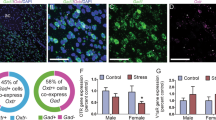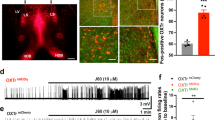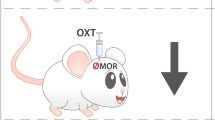Abstract
The nonapeptide oxytocin is considered beneficial to mental health due to its anxiolytic, prosocial and antistress effects, but evidence for anxiogenic actions of oxytocin in humans has recently emerged. Using region-specific manipulations of the mouse oxytocin receptor (Oxtr) gene (Oxtr), we identified the lateral septum as the brain region mediating fear-enhancing effects of Oxtr. These effects emerge after social defeat and require Oxtr specifically coupled to the extracellular signal–regulated protein kinase pathway.
This is a preview of subscription content, access via your institution
Access options
Subscribe to this journal
Receive 12 print issues and online access
$209.00 per year
only $17.42 per issue
Buy this article
- Purchase on Springer Link
- Instant access to full article PDF
Prices may be subject to local taxes which are calculated during checkout


Similar content being viewed by others
References
Carter, C.S. Psychoneuroendocrinology 23, 779–818 (1998).
Ayers, L.W., Missig, G., Schulkin, J. & Rosen, J.B. Neuropsychopharmacology 36, 2488–2497 (2011).
Ishak, W.W., Kahloon, M. & Fakhry, H. J. Affect. Disord. 130, 1–9 (2011).
Bartz, J.A. et al. Proc. Natl. Acad. Sci. USA 107, 21371–21375 (2010).
Grillon, C. et al. Mol. Psychiatry advance online publication, doi:10.1038/mp.2012.156. (13 November 2012).
Striepens, N. et al. Proc. Natl. Acad. Sci. USA 109, 18144–18149 (2012).
Tabak, B.A., McCullough, M.E., Szeto, A., Mendez, A.J. & McCabe, P.M. Psychoneuroendocrinology 36, 115–122 (2011).
Yoshida, M. et al. J. Neurosci. 29, 2259–2271 (2009).
Sheehan, T.P., Chambers, R.A. & Russell, D.S. Brain Res. Brain Res. Rev. 46, 71–117 (2004).
Sato, K. et al. Biosci. Biotechnol. Biochem. 73, 2145–2148 (2009).
Tronson, N.C. et al. Biol. Psychiatry 68, 1007–1015 (2010).
Ebner, K., Wotjak, C.T., Landgraf, R. & Engelmann, M. Brain Res. 872, 87–92 (2000).
Ferguson, J.N., Young, L.J. & Insel, T.R. Front. Neuroendocrinol. 23, 200–224 (2002).
Takayanagi, Y. et al. Proc. Natl. Acad. Sci. USA 102, 16096–16101 (2005).
Thor, D.H. & Holloway, W.R. J. Comp. Physiol. Psychol. 96, 1000–1006 (1982).
Cao, J.L. et al. J. Neurosci. 30, 16453–16458 (2010).
Revest, J.M. et al. Nat. Neurosci. 8, 664–672 (2005).
Devost, D., Wrzal, P. & Zingg, H.H. Prog. Brain Res. 170, 167–176 (2008).
Pagani, J.H., Lee, H.J. & Young, W.S. III. Genes Brain Behav. 10, 710–719 (2011).
Knobloch, H.S. et al. Neuron 73, 553–566 (2012).
Radulovic, J., Ruhmann, A., Liepold, T. & Spiess, J. J. Neurosci. 19, 5016–5025 (1999).
Paxinos, G. & Franklin, K.B. The mouse brain in stereotaxic coordinates (San Diego Academic Press, 2001).
Roche, K.E. & Leshner, A.I. Science 204, 1343–1344 (1979).
Eldredge, L.C. et al. Development 135, 2949–2957 (2008).
Tronson, N.C. et al. Neuropharmacology 33, 1570–1583 (2008).
Stanciu, M. et al. Brain Res. Mol. Brain Res. 94, 15–24 (2001).
Mutso, A.A. et al. J. Neurosci. 32, 5747–5756 (2012).
Acknowledgements
This research was supported by US National Institutes of Health grants R01 MH078064 (J.R.) and MH092065 (Y.F.G.). Part of this study carried out by K.N. and K.S. was the result of “Molecular study of the functional mechanism of oxytocin in brain” carried out under the Strategic Research Program for Brain Sciences by the Ministry of Education, Culture, Sports, Science and Technology of Japan. We thank P. Osten (Cold Spring Harbor) for providing the rAAV-Cre vector, and L. Li and W.G. Tourtellotte (Department of Pathology, Northwestern University) for providing B6.129S4-Gt(ROSA) mice and their help with the β-galactosidase staining.
Author information
Authors and Affiliations
Contributions
Y.F.G. performed all of the experiments and data analyses, Y.F.G. and J.R. designed the studies and wrote the paper, K.S., H.M. and K.N. developed the rAAV-Oxtr and rAAV-GFP viral vectors, K.N. provided the OxtrloxP/loxP and Venus reporter mice, N.C.T. developed the model of social defeat, V.J. helped with the quantitative PCR analyses, and A.L.G. bred and genotyped the mice.
Corresponding author
Ethics declarations
Competing interests
The authors declare no competing financial interests.
Supplementary information
Supplementary Figures and Text
Supplementary Figures 1–6 (PDF 671 kb)
Source data
Rights and permissions
About this article
Cite this article
Guzmán, Y., Tronson, N., Jovasevic, V. et al. Fear-enhancing effects of septal oxytocin receptors. Nat Neurosci 16, 1185–1187 (2013). https://doi.org/10.1038/nn.3465
Received:
Accepted:
Published:
Issue Date:
DOI: https://doi.org/10.1038/nn.3465
This article is cited by
-
Social buffering in rats reduces fear by oxytocin triggering sustained changes in central amygdala neuronal activity
Nature Communications (2024)
-
A dedicated hypothalamic oxytocin circuit controls aversive social learning
Nature (2024)
-
CD38 genetic variation is associated with increased personal distress to an emotional stimulus
Scientific Reports (2024)
-
Detection, processing and reinforcement of social cues: regulation by the oxytocin system
Nature Reviews Neuroscience (2023)
-
Hyperactivity of the Lateral Septum Leads to Hypersensitivity in Susceptible Mice
Neuroscience Bulletin (2023)



